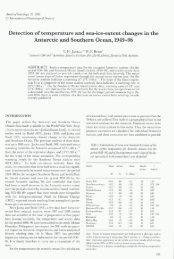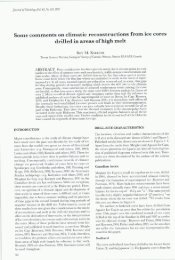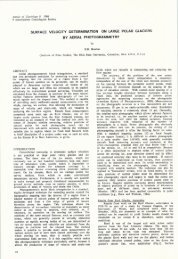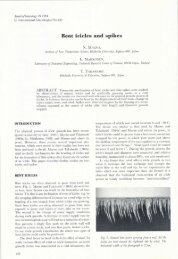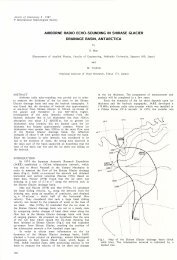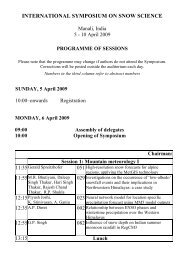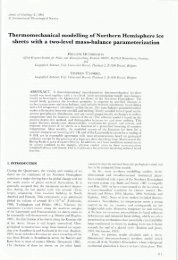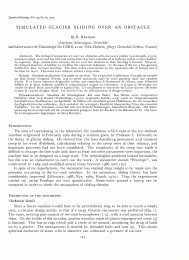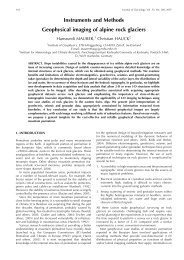on the albedo of snow in antarctica - International Glaciological ...
on the albedo of snow in antarctica - International Glaciological ...
on the albedo of snow in antarctica - International Glaciological ...
You also want an ePaper? Increase the reach of your titles
YUMPU automatically turns print PDFs into web optimized ePapers that Google loves.
Joumal 0/ Glaciology, Vol. 34, No. 116, 1988<br />
ON THE ALBEDO OF SNOW IN ANTARCTICA:<br />
A CONTRIBUTION TO I.A.G.O.*<br />
By GERD WENDLER and JOHN KELLEY t<br />
(Geophysical Institute, University <strong>of</strong> Alaska, Fairbanks, Alaska 99775-0800, U.S.A.)<br />
ABSTRACT. As part <strong>of</strong> a larger experiment, detailed<br />
<strong>albedo</strong> measurements were carried out dur<strong>in</strong>g <strong>the</strong> austral<br />
summer <strong>of</strong> 1985-86 <strong>in</strong> <strong>the</strong> dry-<strong>snow</strong> z<strong>on</strong>e (1560 m) <strong>of</strong> Terre<br />
Adelie, eastern Antarctica. The follow<strong>in</strong>g results were<br />
found:<br />
(I) Mean <strong>albedo</strong> values were high (around 82.6%). On clear<br />
days, <strong>the</strong> <strong>albedo</strong> showed some dependency <strong>on</strong> <strong>the</strong> solar<br />
elevati<strong>on</strong>. The dependency was slight for solar elevati<strong>on</strong>s<br />
above 12 0 but became larger with low Sun angles.<br />
(2) The <strong>albedo</strong> was found to be a functi<strong>on</strong> <strong>of</strong> cloud amount<br />
and type, <strong>in</strong>creas<strong>in</strong>g with <strong>the</strong> amount and thickness <strong>of</strong><br />
clouds. In white-out c<strong>on</strong>diti<strong>on</strong>s, very high <strong>albedo</strong>s were<br />
found (>90%).<br />
(3) The <strong>albedo</strong> showed a dependency <strong>on</strong> <strong>the</strong> type <strong>of</strong> <strong>snow</strong>.<br />
New <strong>snow</strong> displayed higher values than older <strong>snow</strong>,<br />
whose crystals had been destroyed by mechanical acti<strong>on</strong>.<br />
(4) A simple model was developed to assess <strong>the</strong> <strong>in</strong>fluence<br />
<strong>of</strong> sastrugi <strong>on</strong> <strong>the</strong> <strong>albedo</strong>. This model could expla<strong>in</strong> <strong>the</strong><br />
asymmetric diurnal variati<strong>on</strong> about solar no<strong>on</strong> <strong>of</strong> <strong>the</strong><br />
measured <strong>albedo</strong> above a sastrugi field.<br />
The above four dependencies might expla<strong>in</strong> <strong>the</strong><br />
c<strong>on</strong>siderable discrepancies which can be found <strong>in</strong> <strong>the</strong> litera<br />
ture c<strong>on</strong>cern<strong>in</strong>g <strong>the</strong> <strong>snow</strong> <strong>albedo</strong> <strong>of</strong> Antarctica.<br />
INTRODUCTION<br />
The radiati<strong>on</strong> balance <strong>of</strong> any surface, and with it <strong>the</strong><br />
surface climate, is <strong>in</strong>fluenced by its <strong>albedo</strong>. If <strong>the</strong><br />
reflectivity is high, as it is <strong>in</strong> Antarctica, which is 99%<br />
<strong>snow</strong>-covered, this dependency is str<strong>on</strong>g, as most <strong>of</strong> <strong>the</strong><br />
energy received from <strong>the</strong> Sun is reflected back <strong>in</strong>to space.<br />
Hence, <strong>in</strong> Antarctica <strong>the</strong> radiati<strong>on</strong> balance is negative for<br />
most <strong>of</strong> <strong>the</strong> year. To compensate for this loss, <strong>the</strong> air<br />
warms <strong>the</strong> surface, <strong>the</strong>reby los<strong>in</strong>g energy itself. Hence, a<br />
cold layer <strong>of</strong> air normally lies over <strong>the</strong> Antarctic ice sheet.<br />
This <strong>in</strong>versi<strong>on</strong> layer, be<strong>in</strong>g heavier than <strong>the</strong> air al<strong>of</strong>t at <strong>the</strong><br />
same height fur<strong>the</strong>r down <strong>the</strong> slope, flows downward (kata<br />
batic w<strong>in</strong>d) towards <strong>the</strong> coast <strong>of</strong> <strong>the</strong> Antarctic c<strong>on</strong>t<strong>in</strong>ent<br />
(Maws<strong>on</strong>, 1915). Therefore, <strong>the</strong> <strong>albedo</strong> plays an important<br />
role <strong>in</strong> <strong>the</strong> heat balance <strong>of</strong> <strong>the</strong> whole c<strong>on</strong>t<strong>in</strong>ent, especially<br />
as <strong>the</strong> <strong>snow</strong> <strong>of</strong> Antarctica is mostly dry, and reflects solar<br />
radiati<strong>on</strong> very well. There have been a number <strong>of</strong> excellent<br />
studies <strong>of</strong> this phenomen<strong>on</strong> (Liljequist, 1956; Ho<strong>in</strong>kes, 1960;<br />
Kuhn and o<strong>the</strong>rs, 1977, Carroll and Fitch, 1981; Ishikawa<br />
and o<strong>the</strong>rs, 1982; Yamanouchi, 1983). However, great dis<br />
crepancies <strong>in</strong> <strong>the</strong> <strong>albedo</strong> have been reported, with values<br />
around 80% be<strong>in</strong>g normal. This paper, based <strong>on</strong> measure<br />
ments <strong>in</strong> Terre Adelie, eastern Antarctica, tries to resolve<br />
some <strong>of</strong> <strong>the</strong>se discrepancies by c<strong>on</strong>sider<strong>in</strong>g different physical<br />
processes.<br />
*Interacti<strong>on</strong> Atmosphere-Glacier-ocean.<br />
t Institute <strong>of</strong> Mar<strong>in</strong>e Science, University <strong>of</strong> Alaska,<br />
Fairbanks, Alaska 99775-0800, U .S.A.<br />
LOCATION, INSTRUMENTATION, AND TIME OF<br />
OBSERVATIONS<br />
About 5 years ago, a jo<strong>in</strong>t U.S.-French experiment<br />
commenced to <strong>in</strong>vestigate <strong>the</strong> katabatic w<strong>in</strong>d regime <strong>in</strong><br />
eastern Antarctica (Wendler and Poggi, 1980; Poggi and<br />
o<strong>the</strong>rs, 1982). Associated with this katabatic w<strong>in</strong>d<br />
<strong>in</strong>vestigati<strong>on</strong> were complementary studies <strong>of</strong> <strong>the</strong> surface-heat<br />
budget and <strong>the</strong> <strong>albedo</strong>. Dur<strong>in</strong>g <strong>the</strong> austral summer <strong>of</strong><br />
1985-86, detailed radiative measurements were carried out at<br />
D-47 (Iat. 67 0 23' S., l<strong>on</strong>g. 138 0 43' E.) <strong>in</strong> Terre Adelie (Fig.<br />
I) at an altitude <strong>of</strong> 1560 m. D-47 is located about 110 km<br />
south <strong>of</strong> <strong>the</strong> year-round French Antarctic support stati<strong>on</strong><br />
Dum<strong>on</strong>t d'Urville. The gradient <strong>of</strong> <strong>the</strong> slope is <strong>of</strong> <strong>the</strong> order<br />
<strong>of</strong> 6 x 10-3. Fur<strong>the</strong>rmore, D-47 is <strong>the</strong> site <strong>of</strong> an automatic<br />
wea<strong>the</strong>r stati<strong>on</strong> (A WS), which reports over satellite<br />
throughout <strong>the</strong> year (Renard and Sal<strong>in</strong>as, 1977; Stearns and<br />
Savage, 1981). Hence, a large amount <strong>of</strong> climatological data<br />
is available for this site (Wendler and Kodama, 1985).<br />
Stati<strong>on</strong> D-47 is located above <strong>the</strong> dry-<strong>snow</strong> l<strong>in</strong>e. This<br />
str<strong>on</strong>gly <strong>in</strong>fluences <strong>the</strong> reflectivity <strong>of</strong> <strong>the</strong> <strong>snow</strong>. The mean<br />
annual temperature is relatively mild (-25.7 ° C). In w<strong>in</strong>ter, a<br />
mean temperature <strong>of</strong> -30. l o C was measured, while <strong>the</strong><br />
summer displayed a mean temperature <strong>of</strong> -17.2 0 C. Positive<br />
temperatures were never measured.<br />
Fig. I. Area map 0/ Terre Adelie. Antarctica.<br />
The mean annual w<strong>in</strong>d speed at D-47 is high<br />
(12.8 m S- I ). The maximum is observed <strong>in</strong> w<strong>in</strong>ter (13.5 m s-I,<br />
seas<strong>on</strong>al mean), while <strong>the</strong> m<strong>in</strong>imum occurs <strong>in</strong> summer<br />
(11.3 m S- I ). The directi<strong>on</strong>al c<strong>on</strong>stancy, which is def<strong>in</strong>ed as<br />
<strong>the</strong> ratio <strong>of</strong> <strong>the</strong> mean w<strong>in</strong>d vector to <strong>the</strong> scalar average<br />
w<strong>in</strong>d speed, has a very large mean annual value <strong>of</strong> 0.94. It<br />
means that w<strong>in</strong>ds that do not come from a south-easterly<br />
directi<strong>on</strong> blow<strong>in</strong>g down <strong>the</strong> slope are rare occurrences.<br />
W<strong>in</strong>ds have two effects <strong>on</strong> <strong>the</strong> <strong>albedo</strong> <strong>of</strong> <strong>snow</strong>:<br />
19
Journal o[ Glaciology<br />
(I) Drift<strong>in</strong>g and blow<strong>in</strong>g <strong>snow</strong> is a very frequent<br />
occurrence. New <strong>snow</strong> is normally redistributed with<strong>in</strong><br />
hours. The mechanical acti<strong>on</strong> <strong>of</strong> <strong>the</strong> blow<strong>in</strong>g <strong>snow</strong><br />
destroys its crystall<strong>in</strong>e structure and changes <strong>the</strong> <strong>albedo</strong>.<br />
Mean diameter <strong>of</strong> <strong>the</strong> crystals was measured at between<br />
100 and 300/Lm.<br />
(2) The str<strong>on</strong>g and persistent w<strong>in</strong>ds form sastrugi (<strong>snow</strong><br />
dunes), which form and disappear aga<strong>in</strong>. Most <strong>of</strong> Terre<br />
Adelie is covered with <strong>the</strong>m (Fig. 2), and <strong>the</strong>y are<br />
usually directed al<strong>on</strong>g <strong>the</strong> l<strong>in</strong>e <strong>of</strong> <strong>the</strong> resultant w<strong>in</strong>d<br />
vector. S<strong>in</strong>ce sastrugi are not randomly directed, <strong>the</strong>y<br />
also have an effect <strong>on</strong> <strong>the</strong> <strong>albedo</strong>.<br />
The follow<strong>in</strong>g <strong>in</strong>strumentati<strong>on</strong> was used:<br />
PD-4 Davos pyranometer for short-wave <strong>in</strong>com<strong>in</strong>g and<br />
reflected radiati<strong>on</strong>.<br />
Eppley Star pyranometer for short-wave <strong>in</strong>com<strong>in</strong>g radiai<strong>on</strong>.<br />
PD-I Davos pyranometer as a portable <strong>in</strong>strument to<br />
measure <strong>albedo</strong> over different surfaces.<br />
Fig. 2. A sastrugi field as observed at D-47, Terre Adelie,<br />
Antarctica. Sastrugi height: 20-30 cm, <strong>in</strong> extreme cases:<br />
I m.<br />
The <strong>in</strong>struments measure <strong>the</strong> whole visible and near<strong>in</strong>fra-red<br />
spectrum. The glass domes (WG7 and 295) <strong>of</strong> <strong>the</strong><br />
<strong>in</strong>struments have a wavelength range from 281 to 2800 nm.<br />
As a calibrati<strong>on</strong> <strong>in</strong>strument, a L<strong>in</strong>ke-Feussner act<strong>in</strong>ometer<br />
(No. 700 207), which had been compared to <strong>the</strong> United<br />
States Standards <strong>in</strong> Boulder, Colorado, was used. All data,<br />
with <strong>the</strong> excepti<strong>on</strong> <strong>of</strong> <strong>the</strong> L<strong>in</strong>ke-Feussner act<strong>in</strong>ometer, were<br />
recorded <strong>on</strong> a Campbell CR 7 data logger. Measurements<br />
were taken every 10 s. These data were averaged over<br />
10 m<strong>in</strong> <strong>in</strong>tervals and recorded electr<strong>on</strong>ically as well as<br />
pr<strong>in</strong>ted out <strong>in</strong> real time to yield immediate data c<strong>on</strong>trol.<br />
The measurements were taken <strong>in</strong> November and December<br />
1985. Calibrati<strong>on</strong> was carried out at <strong>the</strong> beg<strong>in</strong>n<strong>in</strong>g and end<br />
<strong>of</strong> <strong>the</strong> observati<strong>on</strong>al period. Complete data sets are available<br />
for 33 d. Of this period, 15 d were clear, 13 d were partly<br />
cloudy, and 5 d had overcast c<strong>on</strong>diti<strong>on</strong>s.<br />
ALBEDO AND SOLAR ELEVATION<br />
Typical values <strong>of</strong> <strong>the</strong> <strong>albedo</strong> <strong>of</strong> <strong>the</strong> <strong>snow</strong> were about<br />
80%. These high values might be expla<strong>in</strong>ed by <strong>the</strong> fact that<br />
our measur<strong>in</strong>g site was situated above <strong>the</strong> dry-<strong>snow</strong> l<strong>in</strong>e<br />
(Bens<strong>on</strong>, 1962), hence melt<strong>in</strong>g never occurred, nor was<br />
water ever present <strong>in</strong> <strong>the</strong> <strong>snow</strong>. When melt<strong>in</strong>g <strong>of</strong> <strong>snow</strong> does<br />
occur, values substantially lower are normally found<br />
(Dirmhirn and<br />
Weller, 1974).<br />
Trojer, 1955; Kelley, 1973; Wendler and<br />
In Figure 3, <strong>the</strong> <strong>albedo</strong> is plotted for a totally<br />
cloudless day aga<strong>in</strong>st <strong>the</strong> solar elevati<strong>on</strong>. The area over<br />
which <strong>the</strong>se measurements were made was flat. It can be<br />
seen that, for solar elevati<strong>on</strong>s above 12 0 , <strong>the</strong>re is <strong>on</strong>ly a<br />
20<br />
8<br />
i 8<br />
7<br />
T 0<br />
5l<br />
. . . . . .<br />
.11 DEC 19 8 5<br />
. .<br />
o�---------�10�-- ----�2�O------�3�O�-------4�<br />
SOLAR ELEVATION IN DEGREES<br />
. . . . . .<br />
Fig. 3. Albedo o[ <strong>snow</strong> as a [uncti<strong>on</strong> o[ solar elevati<strong>on</strong> [or<br />
a totally clear day o[ summer 1985-86, Terre Adelie,<br />
Antarctica.<br />
slight dependency <strong>of</strong> <strong>the</strong> <strong>albedo</strong> <strong>on</strong> <strong>the</strong> posItIOn <strong>of</strong> <strong>the</strong> Sun.<br />
The observed change <strong>in</strong> reflectivity between 12 0 and 49 0<br />
solar elevati<strong>on</strong> is about 2.5%. However, reflectivity <strong>in</strong>creased<br />
fur<strong>the</strong>r for very low Sun angles. For <strong>the</strong>se data, <strong>the</strong> energy<br />
received decreases, hence <strong>the</strong> relati ve error <strong>in</strong>creases.<br />
Fur<strong>the</strong>rmore, most pyranometers have a cos<strong>in</strong>e effect, which<br />
might become substantial for solar elevati<strong>on</strong>s <strong>of</strong> less than<br />
5 0 . Hence, that part <strong>of</strong> <strong>the</strong> figure should not be given <strong>the</strong><br />
same importance as <strong>the</strong> rest.<br />
The results <strong>of</strong> <strong>the</strong>se observati<strong>on</strong>s <strong>of</strong> variati<strong>on</strong>s <strong>in</strong> <strong>albedo</strong><br />
are similar to o<strong>the</strong>r studies, for example, Ambach (I 963) <strong>in</strong><br />
Greenland, and Wendler and Streten (1969) <strong>in</strong> south-eastern<br />
Alaska. No dependency <strong>of</strong> <strong>albedo</strong> <strong>on</strong> solar elevati<strong>on</strong> could<br />
be established for cloudy days.<br />
ALBEDO AND CLOUD INESS<br />
As l<strong>on</strong>g as no new <strong>snow</strong>fall occurs, <strong>the</strong> <strong>albedo</strong> is fairly<br />
c<strong>on</strong>stant for reas<strong>on</strong>ably high solar elevati<strong>on</strong>s. However, large<br />
variati<strong>on</strong>s were observed when cloud<strong>in</strong>ess appeared, which<br />
could not be expla<strong>in</strong>ed by changes <strong>in</strong> <strong>snow</strong> c<strong>on</strong>diti<strong>on</strong>s.<br />
When clouds are present, <strong>the</strong> radiati<strong>on</strong> received at <strong>the</strong><br />
surface is diffuse, while under a clear sky about 85% <strong>of</strong><br />
<strong>the</strong> <strong>in</strong>com<strong>in</strong>g radiati<strong>on</strong> is directed. As <strong>the</strong> diffuse and direct<br />
radiati<strong>on</strong> have a somewhat different spectrum (Couls<strong>on</strong>,<br />
1975), and <strong>the</strong> reflectivity <strong>of</strong> <strong>the</strong> <strong>snow</strong> is wave-dependent<br />
(Dirmhirn and Eat<strong>on</strong>, 1974), variati<strong>on</strong>s <strong>in</strong> <strong>the</strong> <strong>albedo</strong> are to<br />
be expected. More recently, Warren (1982) summarized <strong>the</strong><br />
state <strong>of</strong> knowledge, and detailed work has been carried out<br />
by Carroll and Fitch (1981), Grenfell and o<strong>the</strong>rs (I 981), and<br />
Grenfell and Perovich (1984). Grenfell and o<strong>the</strong>rs (1981)<br />
gave spectral <strong>albedo</strong>s between 380 and 2500 nm for a <strong>snow</strong><br />
cover <strong>in</strong> <strong>the</strong> Cascade Mounta<strong>in</strong>s, Grenfell and Perovich<br />
(I 984) for partly <strong>snow</strong>-covered sea ice, and Carroll and<br />
Fitch (1981) worked at <strong>the</strong> South Pole. They showed clearly<br />
that <strong>the</strong> reflectivity <strong>of</strong> <strong>the</strong> <strong>snow</strong> <strong>in</strong> <strong>the</strong> short-wave (visible)<br />
part <strong>of</strong> <strong>the</strong> solar spectrum is very high (>90%), while<br />
reflectivity <strong>in</strong> <strong>the</strong> near-<strong>in</strong>fra-red regi<strong>on</strong> is substantially<br />
lower (about 20% mean value for 1500-2500 nm). Warren<br />
and Wiscombe (I980) carried out <strong>the</strong>oretical calculati<strong>on</strong>s <strong>of</strong><br />
<strong>the</strong> spectral <strong>albedo</strong> which are <strong>in</strong> good agreement with <strong>the</strong><br />
measurements <strong>of</strong> <strong>the</strong> above-menti<strong>on</strong>ed authors. As <strong>the</strong><br />
energy <strong>of</strong> <strong>the</strong> solar spectrum <strong>in</strong> <strong>the</strong>se larger wavelengths is<br />
low, a comb<strong>in</strong>ed <strong>albedo</strong> <strong>of</strong> 83% for clean Antarctic <strong>snow</strong> is<br />
reas<strong>on</strong>able. Clouds also absorb more <strong>in</strong> <strong>the</strong> near-<strong>in</strong>fra-red<br />
than <strong>the</strong> visible; a decrease <strong>of</strong> <strong>the</strong> <strong>in</strong>fra-red comp<strong>on</strong>ent<br />
relative to <strong>the</strong> visible part <strong>of</strong> <strong>the</strong> irradiance with <strong>in</strong>creas<strong>in</strong>g<br />
cloud cover was determ<strong>in</strong>ed by Grenfell and Perovich<br />
(1984). ; is fur<strong>the</strong>r magnified if multiple reflecti<strong>on</strong><br />
between ghly reflective surfaces occurs (Wendler and<br />
o<strong>the</strong>rs, I �lS I), and can result <strong>in</strong> a substantial <strong>in</strong>crease <strong>in</strong> <strong>the</strong><br />
<strong>albedo</strong>. Grenfell and Perovich (1984) found values up to<br />
15% for Barrow, Alaska - similar to values presented<br />
here.<br />
In Figure 4 <strong>the</strong> <strong>albedo</strong> <strong>of</strong> <strong>the</strong> <strong>snow</strong> surface is given<br />
for different types <strong>of</strong> cloud. For each case, six<br />
measurements are given, each c<strong>on</strong>sist<strong>in</strong>g <strong>of</strong> <strong>the</strong> mean <strong>of</strong> 60<br />
<strong>in</strong>dividual measurements. In general, it can be seen that <strong>the</strong><br />
thicker <strong>the</strong> cloud, <strong>the</strong> higher <strong>the</strong> <strong>albedo</strong>. While clear-sky<br />
c<strong>on</strong>diti<strong>on</strong>s yield <strong>albedo</strong> values <strong>of</strong> around 82%, this value<br />
<strong>in</strong>creased to 83.5% for cirro-stratus clouds, to 86.5% for<br />
alto-stratus clouds, and to even higher values for stratus<br />
cloud cover. The figure also shows that <strong>the</strong> scatter <strong>in</strong> <strong>the</strong><br />
data po<strong>in</strong>ts is more pr<strong>on</strong>ounced for cloudy c<strong>on</strong>diti<strong>on</strong>s than<br />
for clear sky. This is understandable, as even <strong>the</strong> same k<strong>in</strong>d
Wendler and Kelley: Albedo <strong>of</strong> <strong>snow</strong> <strong>in</strong> Antarctica<br />
100 TIME<br />
.. 90<br />
0<br />
0<br />
UJ<br />
Journal 0/ Glaciology<br />
SASTRUGl TYPE<br />
TYPE A<br />
TYPE B<br />
TYPE C<br />
Fig. 6. Assumpti<strong>on</strong>s 0/ sastrugi geometry for model<br />
calculati<strong>on</strong>s.<br />
<strong>in</strong>put, three different assumpti<strong>on</strong>s for <strong>the</strong> form <strong>of</strong> <strong>the</strong><br />
sastrugi were made (Fig. 6):<br />
(a) Sastrugi are c<strong>on</strong>sidered as walls perturb<strong>in</strong>g <strong>the</strong> <strong>snow</strong><br />
surface.<br />
(b) Sastrugi are c<strong>on</strong>sidered as semi-circles perturb<strong>in</strong>g<br />
<strong>the</strong> <strong>snow</strong> surface.<br />
(c) Sastrugi are c<strong>on</strong>sidered as ellipses perturb<strong>in</strong>g <strong>the</strong><br />
<strong>snow</strong> surface.<br />
Cases (a) and (b) can be regarded as special situati<strong>on</strong>s<br />
<strong>of</strong> case (c). Referr<strong>in</strong>g to Figure 8, case (a) is <strong>the</strong> situati<strong>on</strong><br />
<strong>in</strong> which a = 0, and <strong>in</strong> case (b) a = b. The azimuth (AZ)<br />
and elevati<strong>on</strong> (EL) <strong>of</strong> <strong>the</strong> Sun were calculated for <strong>the</strong> time<br />
<strong>of</strong> <strong>the</strong> day and day <strong>of</strong> <strong>the</strong> year, us<strong>in</strong>g <strong>the</strong> method <strong>of</strong><br />
Walraven (1978). The angle (E) at which <strong>the</strong> Sun's rays<br />
strike <strong>the</strong> horiz<strong>on</strong>tal surface is calculated from azimuth,<br />
elevati<strong>on</strong>, and sastrugi directi<strong>on</strong> (D) us<strong>in</strong>g <strong>the</strong> equati<strong>on</strong>:<br />
[ tan(EL)<br />
arctan<br />
cos(AZ x D +<br />
A coord<strong>in</strong>ate system is <strong>the</strong>n <strong>in</strong>troduced with its <strong>on</strong>gm at<br />
<strong>the</strong> center <strong>of</strong> <strong>the</strong> ellipse, and axes al<strong>on</strong>g <strong>the</strong> axes <strong>of</strong> <strong>the</strong><br />
ellipse. The (x,y) coord<strong>in</strong>ate <strong>of</strong> <strong>the</strong> po<strong>in</strong>t at which <strong>the</strong> Sun's<br />
rays are tangential to <strong>the</strong> elliptical sastrugi is <strong>the</strong>n calculated<br />
us<strong>in</strong>g <strong>the</strong> follow<strong>in</strong>g series <strong>of</strong> equati<strong>on</strong>s.<br />
c = (a 2 - b 2 ) !,<br />
n<br />
ex = 2 - E,<br />
13 = arcs<strong>in</strong> [: s<strong>in</strong> ex l<br />
[S<strong>in</strong>( ex - 13) ]<br />
r = 2c ,<br />
1<br />
s<strong>in</strong>(213)<br />
r 2 = 2a - rl'<br />
X =<br />
r 2 - r 2<br />
2 1<br />
4c<br />
y (r� - (x + c) 2 ) +<br />
where (-c,O) and (c,O) are <strong>the</strong> foci <strong>of</strong> <strong>the</strong> ellipse, and ex, 13,<br />
r I' r 2 , x, and y are as <strong>in</strong> Figure 7.<br />
There are two possibilities for <strong>the</strong> percentage <strong>of</strong> <strong>the</strong><br />
surface <strong>in</strong> shadow. In <strong>the</strong> first case (Fig. 8a), <strong>the</strong> shadow<br />
22<br />
(0, 0)<br />
Fig. 7. Sastrugi model with features labelled.<br />
E = angle at which <strong>the</strong> Sun's rays strike sastrugi.<br />
(x,y) = po<strong>in</strong>t at which <strong>the</strong> Sun's rays are tangential to<br />
sastrugi.<br />
ri' r 2 = radii 0/ ellipse at (x,y).<br />
I = perpendicular to <strong>the</strong> Sun's rays at <strong>the</strong> po<strong>in</strong>t (x,y).<br />
S<strong>in</strong>ce <strong>the</strong> sastrugi are modelled as ellipses, this l<strong>in</strong>e<br />
bisects <strong>the</strong> angle between r 1 and r 2 '<br />
13 angle between I and radii.<br />
ex = angle formed by I and <strong>the</strong> x-axis.<br />
�2b<br />
(0, 0)<br />
Fig. 8. Sastrugi model with features labelled.<br />
a = <strong>on</strong>e-hal/ <strong>the</strong> width 0/ <strong>the</strong> sastrugi.<br />
b = height 0/ sastrugi.<br />
S distance between sastrugi,<br />
z = distance between <strong>the</strong> po<strong>in</strong>t at which <strong>the</strong> Sun's rays<br />
hit <strong>the</strong> adjacent sastrug; and <strong>the</strong> major axis 0/ that<br />
sastruga.<br />
does not reach <strong>the</strong> adjacent sastrugi. The percentage <strong>of</strong><br />
surface <strong>in</strong> shadow is <strong>the</strong>n given by <strong>the</strong> formula:<br />
100ylS tan(E)<br />
where S is <strong>the</strong> distance between <strong>the</strong> sastrugi, and E and y<br />
are as above.<br />
In <strong>the</strong> sec<strong>on</strong>d case, at relatively low solar angles, <strong>the</strong><br />
adjacent sastrugi <strong>in</strong>terfere with <strong>the</strong> shadow (Fig. 8b). The<br />
percentage is given by:
where<br />
and<br />
z<br />
100(S - x - z)/S<br />
a (mta<br />
t<br />
+ b(a 2 m 2 - t 2 + b 2)<br />
a 2 m 2 + b 2<br />
m = tan(-E),<br />
t = ym(x + S),<br />
S, x, y, a, b, and E are as above, and z is as shown <strong>in</strong><br />
Figure 8b.<br />
For our model <strong>of</strong> <strong>the</strong> mean <strong>albedo</strong> we made two<br />
assumpti<strong>on</strong>s:<br />
(I) The reflectivity <strong>of</strong> <strong>snow</strong> for a horiz<strong>on</strong>tal surface<br />
exposed to <strong>the</strong> Sun is SO% <strong>of</strong> <strong>the</strong> global radiati<strong>on</strong>.<br />
(2) The reflectivity <strong>of</strong> shaded <strong>snow</strong>, <strong>in</strong>dependent <strong>of</strong> its<br />
exposure, is 15% <strong>of</strong> <strong>the</strong> global radiai<strong>on</strong>.<br />
Actually, <strong>the</strong> amount <strong>of</strong> sky radiati<strong>on</strong> <strong>on</strong> <strong>the</strong> global<br />
radiati<strong>on</strong> is somewhat smaller; however, multiple reflecti<strong>on</strong><br />
between slopes <strong>of</strong> different exposure raises <strong>the</strong> radiati<strong>on</strong><br />
received <strong>on</strong> shaded surfaces.<br />
Fur<strong>the</strong>rmore, for our calculati<strong>on</strong>s, a solar ephemeris <strong>of</strong><br />
20 ° was assumed, which was about <strong>the</strong> value observed at<br />
<strong>the</strong> time we made our measurements.<br />
.':<br />
100<br />
80<br />
C<br />
- 60<br />
0<br />
1)<br />
i!J<br />
S)<br />
<br />
0 40<br />
\..<br />
i!J<br />
><br />
Journal 0/ Glaciology<br />
-"<br />
c<br />
-<br />
0<br />
"tl<br />
(lJ<br />
.Jj<br />
<br />
The mean <strong>of</strong> this distributi<strong>on</strong> was taken to be 120 0 , <strong>the</strong><br />
same directi<strong>on</strong> as was used <strong>in</strong> Figure 13. A numerical<br />
<strong>in</strong>tegrati<strong>on</strong> was performed over <strong>the</strong> range <strong>of</strong> <strong>the</strong> distributi<strong>on</strong><br />
to determ<strong>in</strong>e a new average modelled <strong>albedo</strong>. This method<br />
does not take <strong>in</strong>to account <strong>the</strong> complex <strong>in</strong>terference patterns<br />
<strong>of</strong> <strong>the</strong> several sastrugi directi<strong>on</strong>s; however, it is adequate<br />
for our purpose.<br />
Some improvement was found <strong>in</strong> <strong>the</strong> average per cent<br />
difference between real and modelled values us<strong>in</strong>g this<br />
method. The m<strong>in</strong>imum per cent difference <strong>of</strong> 1.42% was<br />
found when <strong>the</strong> standard deviati<strong>on</strong> <strong>of</strong> <strong>the</strong> sastrugi directi<strong>on</strong><br />
was taken to be 25 0 . This compared with 2.03% average<br />
difference for <strong>the</strong> model with <strong>on</strong>ly <strong>on</strong>e sastrugi directi<strong>on</strong>.<br />
CONCLUSION<br />
Albedo was measured at an undisturbed site <strong>in</strong> Terre<br />
Adelie. The known dependency <strong>of</strong> reflectivity <strong>on</strong> <strong>snow</strong> type,<br />
solar elevati<strong>on</strong>, and amount and type <strong>of</strong> cloud<strong>in</strong>ess could be<br />
dem<strong>on</strong>strated. Warren (1982), <strong>in</strong> his review article, discussed<br />
and expla<strong>in</strong>ed <strong>the</strong>se phenomena. With <strong>the</strong> excepti<strong>on</strong> <strong>of</strong> new<br />
<strong>snow</strong>falls, <strong>the</strong> dependence <strong>on</strong> <strong>snow</strong> type was not very<br />
pr<strong>on</strong>ounced, probably due to <strong>the</strong> fact that <strong>the</strong> crystal size<br />
did not vary substantially from <strong>on</strong>e type to ano<strong>the</strong>r. A<br />
blow<strong>in</strong>g-<strong>snow</strong> device, which measured <strong>the</strong> mean size photoelectrically,<br />
normally gave values between lOO and 200 JLm.<br />
The effect <strong>of</strong> solar elevati<strong>on</strong> is not very large for<br />
heights above 10 0 , and our <strong>in</strong>strumentati<strong>on</strong> did not allow<br />
accurate measurements below this value. Cloud<strong>in</strong>ess can have<br />
a substantial effect <strong>on</strong> <strong>the</strong> <strong>albedo</strong>, as <strong>the</strong> high-reflect<strong>in</strong>g<br />
short-wave part <strong>of</strong> <strong>the</strong> solar spectrum is enhanced by<br />
multiple reflecti<strong>on</strong> between clouds and <strong>snow</strong> cover. Our<br />
values are <strong>in</strong> agreement with those found by Grenfell and<br />
Perovich (l984) north <strong>of</strong> Barrow.<br />
However, <strong>the</strong> asymmetric variati<strong>on</strong> <strong>of</strong> <strong>the</strong> <strong>albedo</strong> we<br />
measured could not be expla<strong>in</strong>ed <strong>in</strong> this way. We developed<br />
a model, tak<strong>in</strong>g <strong>the</strong> form and directi<strong>on</strong> <strong>of</strong> <strong>the</strong> sastrugi <strong>in</strong>to<br />
account. Good agreement between model and field measurements<br />
was obta<strong>in</strong>ed. Fur<strong>the</strong>rmore, <strong>the</strong> <strong>albedo</strong> could be<br />
calculated for o<strong>the</strong>r times <strong>of</strong> <strong>the</strong> year, and it can be stated<br />
generally that <strong>the</strong> effect <strong>of</strong> <strong>the</strong> sastrugi <strong>on</strong> <strong>the</strong> <strong>albedo</strong><br />
becomes more pr<strong>on</strong>ounced with decreas<strong>in</strong>g solar elevati<strong>on</strong>s.<br />
It is believed that this last po<strong>in</strong>t <strong>of</strong> <strong>the</strong> paper is <strong>the</strong> most<br />
important f<strong>in</strong>d<strong>in</strong>g.<br />
ACKNOWLEDGEMENTS<br />
This work was funded by U.S. Nati<strong>on</strong>al Science<br />
Foundati<strong>on</strong> grant 8100 16. Fur<strong>the</strong>rmore, our thanks go to <strong>the</strong><br />
United States Antarctic Research Program and Expediti<strong>on</strong>s<br />
Polaires Fran�aises. Also, we thank our team members, R.<br />
Fl<strong>in</strong>t, Pr<strong>of</strong>essor N. Ishikawa, Or Y. Kodama, G. Mimken, P.<br />
Thiebaud, and I. Widget. Mr F. Brill carried out <strong>the</strong><br />
computer work, for which we are grateful. Fruitful<br />
discussi<strong>on</strong>s with G. Mimken, while walk<strong>in</strong>g over <strong>the</strong> sastrugi<br />
fields, are gratefully acknowledged.<br />
REFERENCES<br />
Ambach, W. 1963. Untersuchungen zum Energieumsatz <strong>in</strong><br />
der Ablati<strong>on</strong>z<strong>on</strong>e des gr<strong>on</strong>H<strong>in</strong>dischen Inlandeises. Expediti<strong>on</strong><br />
Glaciologique Internati<strong>on</strong>ale au Groenland, E.G.l.G.<br />
1957-1960, 4(4).<br />
Bens<strong>on</strong>, C.S. 1962. Strati graphic studies <strong>in</strong> <strong>the</strong> <strong>snow</strong> and<br />
firn <strong>of</strong> <strong>the</strong> Greenland ice sheet. U.S. Army Snow, Ice<br />
and Permafrost Research Establishment. Research Report<br />
70.<br />
Carroll, 1.1., and Fitch, B.W. 198 1. Effects <strong>of</strong> solar elevati<strong>on</strong><br />
and cloud<strong>in</strong>ess <strong>on</strong> <strong>snow</strong> <strong>albedo</strong> at <strong>the</strong> South Pole. Journal<br />
<strong>of</strong> Geophysical Research, 86(C6), 527 1-76.<br />
Couls<strong>on</strong>, K.L. 1975. Solar and terrestrial radiati<strong>on</strong>; methods<br />
and measurements. New York, Academic Press.<br />
Dimhirn, I., and Eat<strong>on</strong>, F. 1974. Some characteristics <strong>of</strong> <strong>the</strong><br />
<strong>albedo</strong> <strong>of</strong> <strong>snow</strong>. Journal <strong>of</strong> Applied Meteorology, 14(3),<br />
375-79.<br />
Welldler alld Kelley: Albedo <strong>of</strong> SIlOW ill Antarctica<br />
Dimhirn, I., alld Trojer, E. 1955. Albedountersuchungen auf<br />
dem H<strong>in</strong>tereisferner. Archiv fur Meteorologie, Geophysik<br />
Ulzd BioklimalOlogie, 6, 400.<br />
Grenfell, T.C., alld Perovich, D.K. 1984. Spectral <strong>albedo</strong>s <strong>of</strong><br />
sea ice and <strong>in</strong>cident solar irradiance <strong>in</strong> <strong>the</strong> sou<strong>the</strong>rn<br />
Beaufort Sea. Journal <strong>of</strong> Geophysical Research, 89(C3),<br />
3573-80.<br />
Grenfell, T.C., Perovich, D.K., and Ogren, I.A. 198 1.<br />
Spectral <strong>albedo</strong>s <strong>of</strong> an alp<strong>in</strong>e <strong>snow</strong>pack. Cold Regiolls<br />
Science and Technology, 4(2), 121-27.<br />
Ho<strong>in</strong>kes, H. 1960. Studies <strong>of</strong> solar radiati<strong>on</strong> and <strong>albedo</strong> <strong>in</strong><br />
<strong>the</strong> Antarctic (Little America V and South Pole, 1957/58.<br />
Archiv fur Meteorologie, Geophysik und Bioklimatologie,<br />
10, 175.<br />
Ishikawa, N., Kobayashi, S., Ohata, T., and Kawaguchi, S.<br />
1982. Some radiati<strong>on</strong> properties at Mizuho Stati<strong>on</strong>, East<br />
Antarctica <strong>in</strong> 1980. Memoirs <strong>of</strong> Nati<strong>on</strong>al Institute <strong>of</strong><br />
Polar Research, Special Issue 24, 19-31.<br />
Kelley, 1.1. 1973. Microclimatological <strong>in</strong>vestigati<strong>on</strong>s near <strong>the</strong><br />
Arctic tundra surface. Proceed<strong>in</strong>gs <strong>of</strong> <strong>the</strong> 25th Anniversary<br />
<strong>of</strong> Naval Arctic Research Laboratory Symposium, 1972,<br />
109-26.<br />
Kuhn, M., Kundla, L.S., and Strosche<strong>in</strong>, L.A. 1977. The<br />
radiati<strong>on</strong> budget at Plateau Stati<strong>on</strong>, Antarctica,<br />
1966- 1967. In Bus<strong>in</strong>ger, I.A. , ed. Meteorological studies<br />
at Plateau Stati<strong>on</strong>, Antarctica. Wash<strong>in</strong>gt<strong>on</strong>, DC, American<br />
Geophysical Uni<strong>on</strong>, 41-73. (Antarctic Research Series,<br />
25.)<br />
Liljequist, G.H. 1956. Energy exchange <strong>of</strong> an Antarctic<br />
<strong>snow</strong>-field. Norwegian-British-Swedish Antarctic Expediti<strong>on</strong>,<br />
1949-52. Scientific Results, 2{l A).<br />
Maws<strong>on</strong>, D., Sir. 19 15. The home <strong>of</strong> <strong>the</strong> blizzard; be<strong>in</strong>g <strong>the</strong><br />
story 0/ <strong>the</strong> Antarctic Australasian Expediti<strong>on</strong>. 191 1- 1914.<br />
L<strong>on</strong>d<strong>on</strong>, He<strong>in</strong>emann.<br />
Poggi, A., and 6 o<strong>the</strong>rs. 1982. Interacti<strong>on</strong> atmosphereglace-ocean<br />
en Antarctique. Meteorologie, 1982, 163-71.<br />
Renard, R.I., and Sal<strong>in</strong>as, M.G. 1977. The history, operati<strong>on</strong><br />
and performance 0/ an experimental automatic wea<strong>the</strong>r<br />
stati<strong>on</strong> <strong>in</strong> Alllarctica. M<strong>on</strong>terey, CA, Naval Postgraduate<br />
School. (NPS-63Rd77 10.)<br />
Stearns, C.R., and Savage M.L. 198 1. A utomatic wea<strong>the</strong>r<br />
stati<strong>on</strong>s, 1980- 198 1. Antarctic Journal 0/ <strong>the</strong> United States.<br />
16(5), 190-92.<br />
Walraven, R. 1978. Calculat<strong>in</strong>g <strong>the</strong> positi<strong>on</strong> <strong>of</strong> <strong>the</strong> Sun.<br />
Solar Energy, 20, 393-97.<br />
Warren, S.G., 1982. Optical properties <strong>of</strong> <strong>snow</strong>. Reviews 0/<br />
Geophysics and Space Physics, 20( 1), 67-89.<br />
Warren, S.G., and Wiscombe, W.1. 1980. A model for <strong>the</strong><br />
spectral <strong>albedo</strong> <strong>of</strong> <strong>snow</strong>. n. Snow c<strong>on</strong>ta<strong>in</strong><strong>in</strong>g atmospheric<br />
aerosols. Journal 0/ <strong>the</strong> Atmospheric Sciences, 37(12),<br />
2734-45.<br />
Wendler, G. In press. On <strong>the</strong> blow<strong>in</strong>g <strong>snow</strong> <strong>in</strong> Adelie Land,<br />
eastern Antarctica - a c<strong>on</strong>tributi<strong>on</strong> to LA.G.O.<br />
Proceed<strong>in</strong>gs <strong>of</strong> <strong>the</strong> Symposium <strong>on</strong> Glacier Fluctuati<strong>on</strong>s and<br />
Climatic Change, Amsterdam, June 1987.<br />
Wendler, G., and Kodama, Y. 1985. Some results <strong>of</strong> climatic<br />
<strong>in</strong>vestigati<strong>on</strong>s <strong>of</strong> Adelie Land, eastern Antarctica.<br />
Zeitschri/t fur Gletscherkunde UIId Glazialgeologie, 21,<br />
319-27.<br />
Wendler, G., and Poggi, A. 1980. Measurements <strong>of</strong> <strong>the</strong><br />
catabatic w<strong>in</strong>d <strong>in</strong> Antarctica. Antarctic Journal <strong>of</strong> <strong>the</strong><br />
United States, 15(5), 193-95.<br />
Wendler, G., and Streten, N. 1969. Short term heat<br />
balance study <strong>on</strong> a Coast Range glacier. Pure and Applied<br />
Geophysics, 77, 68-77.<br />
Wendler, G., and Weller, G. 1974. A heat balance study <strong>on</strong><br />
McCall Glacier, Brooks Range, Alaska: a c<strong>on</strong>tributi<strong>on</strong> to<br />
<strong>the</strong> Internati<strong>on</strong>al Hydrological Decade. Journal 0/<br />
Glaciology, 13(67), 13-26.<br />
Wendler, G., Eat<strong>on</strong>, F.D., and Ohtake, T. 1981. Multiple<br />
reflecti<strong>on</strong> effects <strong>on</strong> irradiance <strong>in</strong> <strong>the</strong> presence <strong>of</strong> Arctic<br />
stratus clouds. Journal 0/ Geophysical Research, 86(C3),<br />
2049-57.<br />
Yamanouchi, T. 1983. Variati<strong>on</strong>s <strong>of</strong> <strong>in</strong>cident solar flux<br />
and <strong>snow</strong> <strong>albedo</strong> <strong>on</strong> <strong>the</strong> solar zenith angle and cloud<br />
cover at Mizuho Stati<strong>on</strong>, Antarctica. Journal <strong>of</strong> <strong>the</strong><br />
Meteorological Society 0/ Japan, 161(6), 879-92.<br />
MS. received 13 February 1987 and <strong>in</strong> revised form 12 October 1987<br />
25




